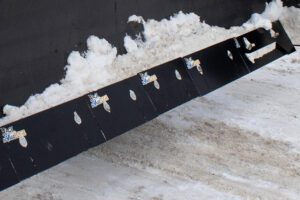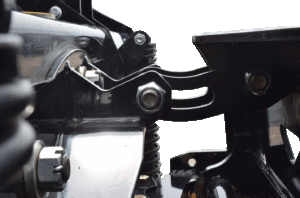When it comes to plowing snow, the better tool for the job is a KAGE snow pusher rather than a loader bucket. In short, this is because a snow pusher, such as a KAGE system, is specifically designed for snow and takes the challenges of snow removal into consideration in the design. A bucket, on the other hand, is designed to move dirt, sand, gravel from one place to another through scooping and dumping. Some of the features of a KAGE snow pusher that make it better than a bucket to remove snow are:
- stacking capabilities
- trip edge
- different cutting edge options
- oscillation
- power angling
- pushing or angle blading
- damage reduction
- safety features
- replaceable components
- size options
Stacking (Why it’s important)

A loader bucket will do the job, but it is a little more time-consuming and tedious and generally can’t stack as high. The operator must scoop up the snow and dump it on top of the pile. Once the boom is tilted, the operator does not have much control of where the snow ends up after that and he or she may have to do clean-up work to get all the dribbles into the pile.
The KAGE system saves time and money in the snow removal industry, especially when compared to a loader bucket.
Benefit of a Trip Edge

A loader bucket is designed to scoop, and sometimes dig, making a trip edge counterproductive for its primary purpose. Therefore, loader buckets do not offer trip edges.
Some other styles of snow plows offer a trip moldboard in which the entire snow blade trips. The benefit of a trip edge over a trip moldboard is that when the operators hit an object, they do not lose their entire load.
Each KAGE system comes standard with a compression spring style cutting-edge, and a bucket does not have one. The reason KAGE plows use a compression spring is because they last longer than extension springs and have minimal wear components.
Different Cutting Edge Options

If for some reason, you prefer a different style of cutting edge, such a rubber, it can be used on any KAGE Snow Pusher or 2-in-1 plow and box system – assuming the cutting edge is equipped with a standard DOT or Highway bolt pattern.
Loader bucket cutting edges, if they are even available are unique to individual manufacturers and oftentimes if models within the same manufacturer. Plus, they are generally welded in place and are not easily replaceable.
Ability to Level and Oscillate

KAGE pusher systems have 12 degrees of oscillation located in the prime spot above the cutting edge to allow for the most precise operation. The oscillation allows the plow to level with the pavement while riding slopes to clean the most snow in one pass – even on crowned surfaces.
Continuously Roll or Throw the Snow

A bucket is designed to scoop and fill with loose material, rather than throw the material. This will not create good momentum with snow, slowing the operator down as the snow packs into the bucket. Once the bucket is full, it becomes more difficult to control where the overflow of snow is deposited and the bucket must be emptied by dumping. Sometimes the snow becomes so packed in corners and creases of the bucket that it can become difficult to dump out the packed snow.
Angle Plowing

A KAGE 2-in-1 snow plow and pusher system, which has the most angling in the industry of 34-36 degrees, can maneuver around obstacles quickly and efficiently without much effort from the operator. Even when the pusher box is full, you can control the overflow through angling the blade and box, making clean windrows for follow-up passes.
Reduce Damage and Increase Safety
A loader bucket is rigid and is more likely to cause damage to property and potentially injure the operator. A bucket does not have built in safety mechanism that cushion the impact of unforeseen objects causing damage to the object that is hit, and potentially the machine and operator.
1. Trip Edge
All KAGE snow pushers are designed to ride over obstacles and cushion as much impact as possible. This is done with the trip edge combined with various other features, depending on the system. The trip edge allows the edge of the blade to snap back when the operator drivers over objects such as manholes and curbs without aggressively stopping the machine and throwing the operator into the windshield.
If the plow is more than 10 feet wide, KAGE plows implement a split trip edge. This means that part of the cutting can trip separately from another part. This allows the trip to happen with the desired level of resistance and prevents excessive twisting of the cutting edge, which could result in damage to the pusher.
2. Crossover Relief Valve
All 2-in-1 KAGE snow plow and pusher systems utilize a crossover relief valve. The crossover relief valve protects the hydraulic system in the machine and plow. This allows the plow to automatically angle to the side when an object is hit on one side of the plow instead of sending the force through the hoses and back into the machine causing a broken connection.
 3. Plastic Skids
3. Plastic Skids
All KAGE pushers also use plastic materials for their skids which is gentler on the substrate than steel shoes or skids.
4. Floating Skids
KAGE offers floating skids on both its SnowFire 2-in-1 system and its Blast snow pusher. These floating skids utilize leaf springs to absorb impact. Floating skids are standard on the Blast pusher and an upgrade option on the SnowFire plow and pusher system.
 5. Floating Quick Attach
5. Floating Quick Attach
Unique to the SnowFire Blast snow pusher is its floating quick attach. This built-in float is designed to accommodate crests and valleys without applying excessive pressure while transitioning from one to the other.
6. Live Cutting Edges
KAGE’s live cutting edges, also known as sectional edges, or flex edges, operate in much the same way the trip edge of or floating skids do. They absorb impact through the use of springs. These spring loaded sections enable part of the cutting edge to absorb the shock without affecting the entire cutting edge, moldboard or pusher system.
Back Drag More Snow

A KAGE 2-in-1 snow pusher and blade system allows you to take off the box and get within a few inches on the object to clear the snow. Optional back drag kits are also available to contain more snow while back dragging.
The KAGE SnowFire Blast snow pusher, despite having fixed sides can get right up to doors and walls with its top mounted back drag kit. This back drag system just requires you to tip the pusher forward, much like you’d do to back drag with a bucket, and the top mounted cutting edge then sticks out in front of the box for better reach and precision back dragging.
Replacement Parts
KAGE systems offer easily replaceable parts, including cutting edges, skids, side panels and more. All KAGE pushers are designed for easy maintenance. Whenever reasonable to do so, parts are bolted on, rather than welded in place.
The cutting edges are a standard highway dot punch and are replaced by simply bolting it on and off. The skids are also bolt on and off with easy access to the hardware.
A bucket, however, is generally a fully welded piece of steel, and once that is twisted or bent, your maintenance person might have to cut apart and reweld or replace the whole thing.
Varying Size Options
The KAGE systems come on a variety of sizes ranging from 6′ to 20′ wide and 32″ to 48″ inches tall depending on the model of pusher and the type of machine it would be used on. Let’s take a look at the KAGE snow pusher size ranges for different machine types.
KAGE Pushers For Skid Steer Loaders up to 15K Pounds
- 6-12 ft width
- 32 in height
KAGE Pusher for Tractors up to 30K Pounds
- 6-14 ft wide
- 32-36 in height
KAGE Pusher for Front End Loaders up to 50K Pounds
- 6-20 ft width
- 32-48 in height
Generally loader buckets have smaller widths than snow pushers. However, they can be purchased in various sizes. The size of your machine greatly influences the options available. As a general rule, below are standard range of options.
Skid Steer Loader Buckets
- 5-7 ft width
- 22-31 in height
Tractor Loader Buckets
- 4-7 ft width
- 20-36 in heigh
Front End Loader Buckets
- 4-11 ft width
- 18-63 in height
Better Containment

Most loader buckets have side panels that angle or taper back from the lower front edge to the rear top edge making a somewhat triangular shape, while snow pushers have side panels that extend out farther to the front and top, making a squarish shape. These pusher side panels cover more area and therefore are able to contain more snow.





Recent Comments